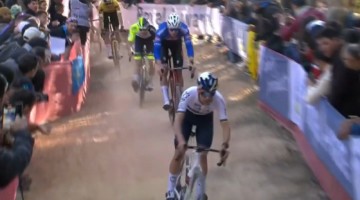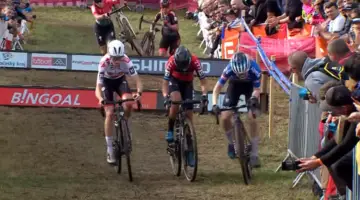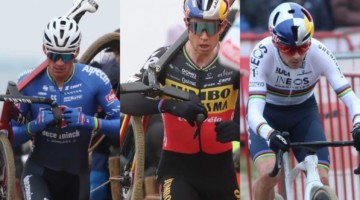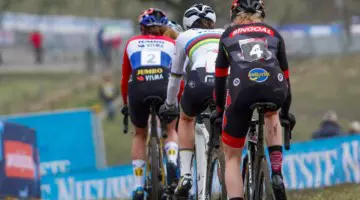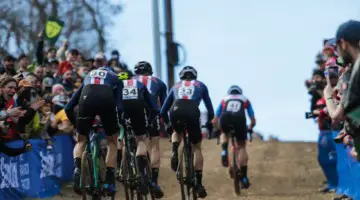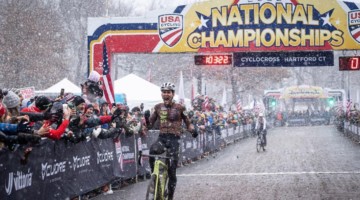Last season, when the opportunity presented itself, Stephen Hyde jumped on a plane to head to Spain to train with the champ, Wout van Aert.
Two weeks ago Hyde went back to Spain, and this time, the U.S. champ brought some friends with him.
“This is kind of Stephen’s doing,” Kerry Werner said. “He has been coming here for three years now and been raving about how cool it is. The flights from Brussels were cheap and we had a perfect window after the Christmas block while Euro Nationals were happening there wasn’t any racing anyway.”
Curtis White agreed, Hyde’s glowing reviews of Malaga were tough to resist. “Stephen had the initial idea of coming down to Spain for some warm weather training. He has spoken very highly of Málaga over the last few years, and it fit perfectly into the schedule.”
With U.S. Nationals in the rearview and the Euros headed home to race their respective National Championships over the weekend, Hyde and a cast of U.S. characters—Werner, White, Kaitie Keough and Gage Hecht— headed to the south of Spain for some sunshine and a block of training before the World Championships.
The group of riders was based in Málaga, located on the southern part of the Iberian Peninsula about a two-hour drive north of Gibraltar. Hyde got the ball rolling by locking down an Airbnb for the two-week block along with teammates White and Keough. Werner got his own spot nearby—a four-minute walk, to be exact. Pro cyclists quantify everything, apparently.
The youngest of the group, Hecht, did what your average 20-year-old—albeit one of the best cyclists in the country—would do: he crashed with some friends. “I ended up emailing Stephen and he offered me some space in his flat that he had rented for the two weeks,” Hecht said.
“Luckily we had a great window with Euro Nats, and I was able to talk a few peeps into meeting up,” Hyde said. “I think everyone was thinking the same thing for this time period. Some had more solid plans than others and it all aligned well enough.”
The New Hot Cycling Spot?
Training in Spain has become a regular part of European cyclocrossers’ seasonal routines. Mid-season, riders head south to escape the Belgian winter and get some much-needed endurance riding in. The approach helps their fitness, but perhaps more importantly, it helps keep them fresh during the long grind of the Belgian cyclocross season.
Last season, both Hyde and Van Aert showed near-immediate benefits from their trip to Spain at the end of November 2017. Hyde had two of his best Euro results ever at Namur and Heusden-Zolder, and Van Aert had one of his two best races of the season—the other being Worlds—at World Cup Namur.
Now in his fifth season of racing in Europe, Hyde quickly adopted the Euro mindset and has now been coming to Spain for a number of years.
“This is my fourth year in a row coming to Spain for training. Some years I get to come mid-season and hit up a training block and other years I come for my downtime post-Worlds and start my base training in the spring,” Hyde said. “We’re based out of Málaga. I’ve been coming here for three years now and consider it one of my homes at this point.”
Blocks of training in warm climates have long been part of professional European road teams, and now, southern Spain is becoming a popular destination for North American cyclists of different stripes.
“We have made a bit of a warm weather hotbed for North American cyclists,” Hyde said. “It all started with some of my New England friends needing somewhere warm to ride and adventure for the road season and it turns out it’s just as cheap to come here as it is to Tucson.”
More athletes training in Málaga also means more and better routes to ride. “There is another group of guys here, the Toronto Hustle Crit squad, specifically Sam Rosenholtz and some Canadian teammates,” Werner said. “Sam is the one that got Stephen interested in this place, so between the two of those guys we have a pretty good wealth of knowledge about what rides and roads are awesome, what to do in the city and where to get the best gelato.”
Perhaps the biggest challenge the group of U.S. ’cross riders faced during the block of training? Coordinating training plans from their respective coaches.
“We all talk about what the rides our coaches have us doing and figure out whose rides are similar enough to go for a ride together,” Hecht said. “We all have been doing a bit of moving things around to make for better training on the harder days.”
“Everyone has been willing to bend in their coaches’ prescribed training to make bigger group rides happen,” Werner added.
Camaraderie and a Little Competition
In cyclocross—as well as other activities—having other peers to train with forces athletes to up their game on a daily basis. It also helps build friendships and provides some company during long days in the saddle.
European cyclocross teams often hold preseason camps, and many Belgium-based athletes live close to one another, allowing them to train together during the season. Every when on the road in the U.S., Euro teams like the Telenet Fidea Lions and Marlux – Bingoal will go on training rides together.
“I think another leg up that a lot of guys in Europe have is the fact that they train together every week,” White said. “It’s not just a couple weeks in the summer. Every week, they are pushing each other in skills training or training on the road together. It’s an added sense of camaraderie.”
Coordinating team training is much more difficult for North American cyclocross riders. The U.S. is a very big country—all of Belgium is roughly the same size as Massachusetts, Connecticut and Rhode Island—and riders are spread across that big country. All of that is to say that this block of training in Spain has been a rare occasion for U.S. cyclocrossers to train together for more than a ride or two.
“The thing that I think most of us miss out on back at home is being able to consistently train with teammates or other professionals,” White said about the Spain block. “We were able to push each other further, get in higher quality work and build up motivation.”
Hyde agreed, “It is great to have so many riders here at once, stepping outside of our respective teams to train and live together. It’s really neat.”
When I interviewed Kerry Werner back in October, I joked that perhaps Kerry and Emily could host other U.S. cyclocrossers at their home near Winston-Salem, North Carolina and make it the new training grounds for U.S. cyclocross. Given the positive vibes of this block of training in Spain, I asked if the riders thought the team training could be replicated in the U.S. this summer.
They all said it would be fun and beneficial, but probably not possible in reality for a couple of reasons that Werner identified.
“The problem we have with training together is one, some guys are on road teams and some aren’t, but more influential to why we all train alone is the distance that separates us,” Werner said. “The U.S. is too big and we are all too spread out, unfortunately. It would be great it just doesn’t seem realistic at this point.”
As an example of the first point, Hecht pointed out he will be racing with his Aevolo Cycling team up until the 2019/20 cyclocross season.
To illustrate the second point, White and Hyde are relatively close together with White in eastern New York and Hyde in Western Massachusettes, and yet they find it hard to get together to train.
“Hyde is the closest top guy to me, and it’s a two-hour drive,” White said. “We barely are able to train together outside of racing trips or blocks in Europe. Everyone else is a plane ride away.”
Despite the challenges, White said making a U.S. ’cross collective work could be worth the sacrifice. “I think that would be a really cool arrangement, and it certainly would be beneficial,” he said.
He added, “While I agree with Kerry that the distance separating all of us is an inconvenience, I think getting our top athletes together for a block next summer is something we should absolutely look into. Upping your game always takes more effort and sacrifice. I’ve been waiting a long time to be able to live 100 percent for cycling. If it makes me a better racer, I’m all for it.”
December versus January Nationals
This block of training in Spain was made possible thanks to the move of U.S. Cyclocross Nationals from January to December. In past years, the U.S. riders would have been racing at Nationals at the same time as their Euro counterparts.
Our analysis of participation at Louisville Nationals showed amateurs were up for racing in December again.
Was the same true of the Elites? Perhaps not surprisingly, the answer was yes.
“I think it’s really nice. It cuts down on the travel and gives us a bit of a break in the season, Hecht said.”
“I wholeheartedly hope that Nationals continue to be a fixture of December racing,” Werner said. “I have really enjoyed coming over to Europe for this extended race block. In the midst of such heavily attended racing, I learned a lot in the first two weeks of being in Belgium after our Nationals. I hope to be able to do the same program next year. After a long season of racing, this block of volume in the warm weather is exactly what I needed.”
“For those of us that are racing the Christmas block in Belgium and planning on making the World Championships team, I absolutely believe a training block like this is better than having our National Championships in January,” White said. “We all want ’cross to grow in the U.S., and I think January Nationals was a necessary experiment. However, if we want to be more competitive at the international level, we need to be spending more time in Europe consistently. Nationals in December allows us to get that consistent block of needed experience without the travel, and we are able to go somewhere to train in between.”
Hyde said that he has come to Spain in the past before January U.S. Nationals and was a bit more philosophic about the current situation, “As long as [Spain] stays close to Belgium, then it will be a hot spot for anyone on this continent to train on.”
Featured image: Kerry Werner























